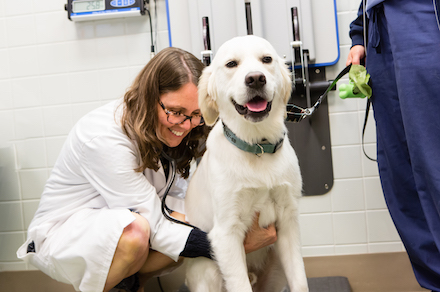Everyday Medicine: Fecal Analysis

Everyday Medicine: Fecal Analysis
Everyday Medicine” is an intermittent series of blog posts highlighting tests, treatments, and procedures common in daily Animal Medical Center practice. Some past examples of this type of blog post include hospital wards and vomiting or regurgitation.
Today’s post focuses on fecal analysis.
The 2011 American Veterinary Medical Association and American Animal Hospital Association Canine Preventive Healthcare Guidelines recommend a minimum of an annual fecal examination to diagnose intestinal parasites. This recommendation explains why your veterinarian gives you a little cup or tube in advance of your dog’s annual exam and asks you to collect a fecal sample. Fecal analysis is frequently part of the testing performed when your dog has a bout of diarrhea.
Visual examination
Most intestinal parasites are not visible to the naked eye. The exception is tapeworms. Tapeworms are a segmented worm and the little segments pass out of the intestine with the stool. Above, you can see the tapeworm segments the owners found when cleaning up after her dog.
Microscopic examination
In cases of acute diarrhea, a bit of stool and some saline mixed on a microscope slide can result in a quick diagnosis of Giardia when your veterinarian sees the little parasites swimming around when the slide is examined using a microscope. Occasionally, if I am are lucky, I might identify a coccidian organism or a worm egg.
Fecal floatation
The fecal floatation technique requires the stool sample to be mixed with a special solution and sometimes the protocol requires centrifugation of the sample. The process causes worm eggs to float up and stick to a coverslip which is then placed on a microscope slide and evaluated. This is thought to be one of the most reliable tests for intestinal parasite like roundworms, hookworms, whipworms, tapeworms and stomach worms.
Baerman technique
While the fecal floatation technique identifies eggs in the stool sample, the Baerman test looks for larva or immature worms. Baerman technique requires special equipment and is not typically done in a private practice but in the commercial veterinary laboratory. This is the test veterinarians use to diagnose lungworms which can cause a chronic cough in dogs.
New generation of fecal analysis
The newest type of fecal analysis uses a technology called enzyme linked immunosorbent assay (ELISA) that recognizes a protein on the parasite. The advantage of this type of test is that the parasite does not have to be shedding eggs for the test to detect an infection like for a fecal floatation. This allows earlier diagnosis and prompt treatment. The most commonly used ELISA detects Giardia infection.
The importance of a fecal analysis in keeping your dog healthy is undeniable, so be sure to bring that sample to your dog’s next examination.




























